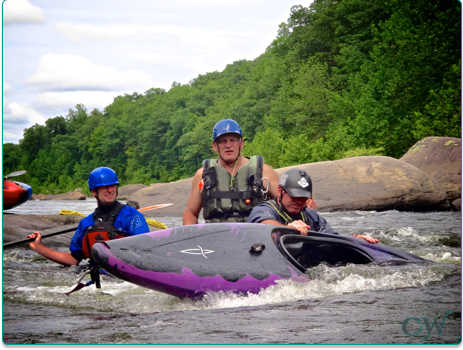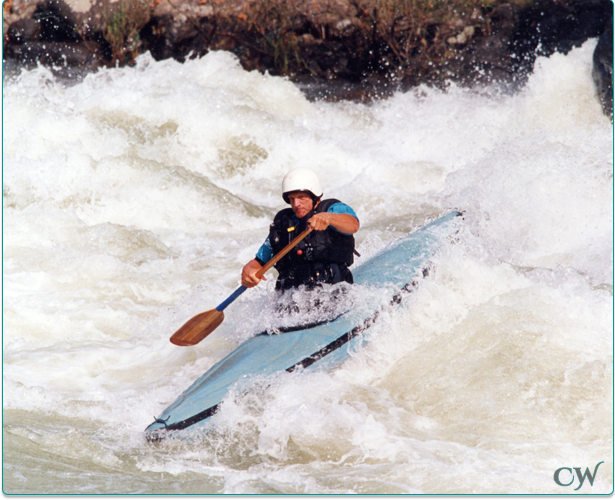The Dynamics of Pinning
Hitting rocks and boulders of all sizes and shapes is a part of river running. Modern boats can take the punishment, but how should the boater deal with the real risks of pinning and entrapment?
Water flows around rocks, not through them. Beginners learn quickly to continue trying to avoid them even when a collision seems imminent. The current almost always pushes them around the rock at the last minute. This river feature doing the pushing is called a pillow, a mass of water which is formed when the current piles up on the upstream face of an obstruction. This makes hitting many boulders harder than it might seem.
Some pillows are so powerful that you can’t paddle through them even if you try. At Pillow Rock rapid you can watch squirt boaters head directly for the left wall. They back-ender in the huge pillow, and wash around the rock. But on smaller rocks, a broached boat goes right through. As it impacts with the rock, it takes a few seconds for the pillow to transfer from the upstream side of the rock to the upstream side of the boat. When this happens, the full force of the river takes hold. If the force is balanced end-to-end, you’re pinned.
When broached, beginners are taught to lean immediately into a rock. This lets the current pass under the boat, keeping the water from grabbing hold. This position is surprisingly stable, but remember: it’s most important to lean the boat, rather than just your body. If the river washes over a kayak deck or canoe gunwale all the downstream body English in the world won’t prevent a pinning. Once this lean is established, you’re in essence riding on top of the pillow. This pile of water gives you time to work, and helps minimize friction as you work the boat off to one side oe the other with your hands.
Slightly undercut rocks are dangerous because no pillow forms. When a paddler broaches on one they’re almost sure to be caught. This is a much more frequent danger than huge undercuts, which are well-known and relatively rare. If a pillow is not forming on a rock, treat it with extra respect. It may well be undercut.
Being able to get out of your boat quickly can be important. As a C-1 paddler, I can stand up in my boat and jump out in a flash. In 1972 I did just that after picking the wrong route on the Upper Yough’s notorious “Lost and Found” rapid and broaching onto an undercut. In a millisecond I was on top of an undercut rock as my C-1 sank beneath it. Getting out fast is much harder in a kayak, and virtually impossible with smaller, old-style cockpits. Anyone who chooses a kayak without a big “keyhole” cockpit these days is asking for trouble in the event of a pin. If pinned upside down, eject. You can’t roll a boat when it’s stuck, so get out while you can.
Practice getting in and out of your canoe or kayak quickly. Note any outfitting problems, then modify your boat accordingly. Each boat and body combination is different, and presents unique outfitting problems. The extra margin that this fine-tuning provides can make a difference in a tight spot, and will contribute to your overall confidence as a boater.
Crashing, bashing, and scraping rocks is not the same as being pinned. While frightening to experience when upside down, as long as your boat is moving you aren’t pinned yet. The same thing is true when “surfing” a pillow. But once a boat sticks to the rock firmly, you only have only a few seconds to escape before the river takes hold. If you’re right-side-up, watch the scenario unfold, and be ready to bail out. Upside down, you’ll have to rely on how it feels. Wait for the hard impact that stops your movement; then eject. You’ll never roll under these conditions. Don’t wait too long to exit your craft.
Pinned boats get caught because the river’s force is balanced at both ends. The way to work them loose is to look carefully at the pin, then decide how to reduce the force on one end or the other. Often just raising one side a bit is enough to unbalance the pin, allowing the force of the water at the opposite end of the boat to pivot your craft free. Mechanical systems and attempts to unpin boats by pulling one end back upstream are very time consuming, and should only be used as a last resort.
End to end pins can be particularly frustrating. Here both ends of the boat have snagged on closely-placed obstructions. In mild current you may be able to bounce your boat and wiggle free. Certainly you’ll be able to hop out easily. If the water is powerful, get out at once, before the current grabs hold. There’s simply no easy way to work free except lifting one end or the other up over one of the obstructions, or pulling or pushing the boat until it slides forward or backwards enough to swing past one of the rocks that snagged it.
When a decked boat pins bow-first, the paddler is stopped right in the middle of the current. The pillow builds up on the paddler almost instantly, putting pressure on the boater and shortening escape time. The pillow also forms the air pocket which may help people breathe in some of the more extreme examples. Rescue is a pretty grueling affair, and I recommend the use of high-volume boats and good judgment to avoid trouble.
All of these things take experience to recognize. Using these ideas, be alert to your own observations as you paddle. Never stop thinking. Remember: you can either have five years experience or one year’s experience repeated five times.





